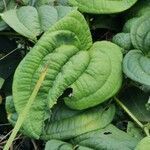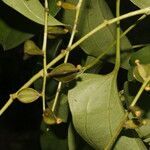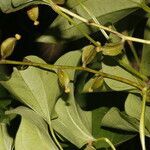Plants tuberous; tubers 1–many, stalked and ± deeply buried, elongate (highly polymorphic), often massive, weighing up to several kg, flesh starchy, white or variously colored. Stems twining clockwise, climbing up to 20 m, broadly winged, 4-angular, producing bulbils up to 4 cm in diam. in leaf axils, wings often purplish. Leaves alternate proximally, opposite and ultimately decussate distally, 6–16 × 4–13 cm; petiole ca. as long as blade, winged, base clasping, basal lobes stipulate, growing as extensions of wings, less than 1 mm wide; blade 5–7-veined, ovate, glabrous, base typically sagittate, margins entire, apex acute to acuminate. Staminate inflorescences axillary, 1–2 per axil, paniculate, fasciculate; panicles bearing flowers singly, bracteolate, in a zigzag pattern along rachis, internodes less than 2 mm; rachis to 25 cm, secondary axes 1–3(–6), fasciculate, less than 3 cm, each subtended by deltate-ovate bracteole shorter than 1 mm. Pistillate inflorescences solitary, 4–8(–20)-flowered, 6–35 cm, internodes ca. 1 cm. Staminate flowers: perianth whitish, cup-shaped; tepals ca. 1 mm, connate at base in 2 subequal whorls, outer widely ovate, inner narrower, apex obtuse to rounded in both; fertile stamens 6 in 2 equal whorls; anthers longer than filaments, thecae distinct, not spreading. Pistillate flowers: perianth lightly colored; tepals broadly ovate, ca. 1 mm, fleshy; staminodes 6, smaller than fertile stamens. Capsules not reflexed at maturity, broadly ovate, ca. 2 × 3.5 cm. Seeds winged all around. 2n = 30, 40, 50, 60, 70, 80.
Tuber replaced annually, normally cylindric, up to 6 cm. in diameter, descending vertically, but in some cultivars very diversely shaped, branched or expanded above, sometimes with lobes curved or spreading horizontally.. Twining stems 4-winged or-angled, up to 10 m. long, glabrous.. Leaves opposite or the lower alternate, glabrous; petiole up to 9(–10) cm. long; blade ovate with widely cordate almost hastate base, apically narrowed to an acute acumen, up to 12(–13) cm. long and 8(–10) cm. broad.. Aerial tubers subglobose or irregularly and narrowly ovoid, up to 12 cm. long.. Inflorescences glabrous.. Male ± 2 in the leaf-axils or forming axillary terminal panicles in the axils of bracts, spreading; axis zigzag, with the sessile flowers directed forwards and outwards; perianth subglobose, not opening widely, ±1.5 mm. across.. Female 1 per leaf-axil, up to 21(–35) cm. long; perianth triangular-subglobose, ± 5 mm. across. Ovary glabrous.. Capsule as in fig. 1/4, p. 4, up to 3.5 cm. in diameter, glabrous.. Seeds winged all round.
Tubers variable, usually globose or conical (when cork brown or purplish black and transverse section purplish white), or oblate or cylindric, much branched (when cork brown or grayish yellow and transverse section white). Stem twining to right, glabrous, ridged, with 4 narrow, membranous wings, prickly at base. Bulblets present, variable in shape. Leaves alternate basally on stem, opposite distally on stem, simple; petiole green or purplish red, 4--15 cm; leaf blade green or purplish red, ovate, 6--15(--20) × 4--13 cm, papery, glabrous, base sagittate to deeply cordate, apex shortly acuminate or caudate. Male spikes solitary or a few together, 1.5--4 cm, sometimes forming a panicle; rachis obviously zigzagged. Male flowers: outer perianth lobes broadly ovate, 1.5--2 mm; stamens 6. Female spikes solitary or 2 or 3 together. Female flowers: staminodes 6. Capsule not reflexed, oblate, sometimes obcordate, 1.5--2.5 cm; wings 1.2--2.2 cm wide. Seeds inserted near middle of capsule, winged all round. Fl. Nov--Jan, fr. Dec--Jan.
A yam with a long angular vine. It can climb 15 m high. The stems are square and twine to the right around support sticks. The stem does not have spines. It is often coloured green or purple. The leaves are heart shaped and borne in pairs along the vine. The leaves vary is shape, size and colour with different varieties. Leaves can be 10-30 cm long by 5-20 cm wide. The leaf stalk is 6-12 cm long. The flowers occur in the axils of the upper leaves. The male flowers are in small heads along branched stalks. These can be 25 cm long and green. The female flowers are in shorter spikes. Many cultivated varieties do not produce fertile seed. The fruit are 3-winged and 2.5 cm long by 3.5 cm wide. The seeds when they occur have wings right around them. One large but often irregular shaped tuber occurs under the ground. A very large number of different varieties occur. The tubers can vary in shape, size, colour, texture and other ways. Some varieties produce bulbils along the vine. Plants can vary in number of chromosomes.
Tuber globose or pear-shaped to cylindroidal, often lobed. Stems twining, to many metres long, glabrous, with 4 crisped, membranous, longitudinal wings c. 0.5 mm wide. Bulbils globose. Leaves: lamina ovate, 5–25 cm long, 3–15 cm wide, cordate at base, acuminate at apex, 5–9-veined, glabrous; petiole 3–18 cm long, narrowly 5-winged. Male flowers: spikes 1 or 2 per axil, 1–3 cm long; sepals and petals ovate, 1.5–2 mm long, yellow; stamens 6. Female flowers: racemes 1 or 2 per axil, 10–60 cm long; perianth similar to male; staminodes absent. Capsule broadly ovate in lateral view, retuse, 17–20 mm long; lobes to 15 mm wide. Seeds not seen.
Tubers annual, their shape, size and colour very variable according to the cultivars.
Rarely flowering in our area and usually reproducing vegetatively
Glabrous climber with winged stems 10-25 ft. high
Bulbils developed in some forms






